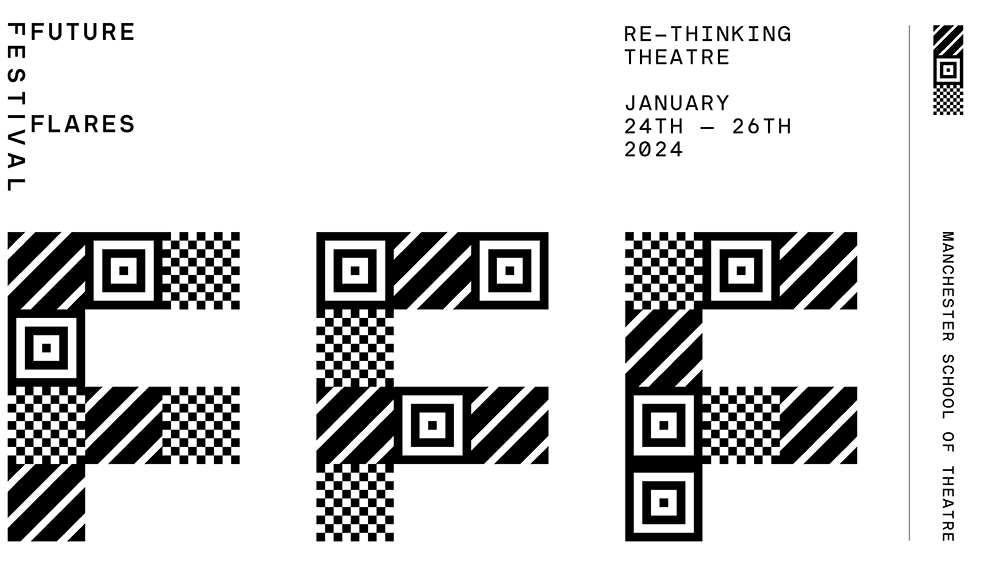Future Flares Festival 2024
Curatorial Statement
The question of context is arguably key to a full understanding of anything, and is central to the curation of the Future Flares Festival 2024, with much of the work being presented questioning its own fit with the immediate context and established function of a theatre. The festival also acknowledges its own complex sense of institutional context, being presented mostly in the new Grosvenor East building by the Manchester School of Theatre, which is in the Manchester School of Art in Manchester Metropolitan University, itself geographically and culturally located in central Manchester.
Enkidu Khaled’s ‘Working Method’ asks what happens if a workshop is presented in a theatre, a workshop on creating theatre, presented with a strong sense of performance, and in front of a theatre audience? The journey his practice has taken from Baghdad to Brussels offers its own, sometimes shocking, commentary on changing contexts, as well as raising questions regarding the practice and function of artistic creation. A String Section by Reckless Sleepers also comes steeped in its own sense of context. As a task-based, performance action with its own oblique references to the context of an orchestra, and one that has been presented 100 times worldwide in mostly external locations, it is here placed into both a theatre and a large semi-public foyer space.
But what happens if you place other arts practices in the context of theatre? Gillian Dyson’s latest work of performance art comes from a visual art tradition, as well as drawing on Butoh, a post-war Japanese body of practice originally translating as the ‘dance of darkness’, whilst speaking to the ideological contexts around feminine aging. Artists Jenny Baines and Brigid McLeer have also facilitated the creation of a large-scale work constructed using a range of practices by visual arts, digital arts and performance students, and are presenting that in a theatre. And Michael Pinchbeck’s latest work offers some considered reflections on a published book, and the photography and writing in it, and their relationship to the act of performance.
The theatre, as a physical space, has long been understood as a place for dramatic representation, for audiences to experience live entertainment, or simply to gather and hear from people who have something to say. In addition to the physical location, each of these different conceptions of its function provides a different sense of context as well, a framework of expectations, conventions and points of reference. The artist who approaches the opportunity to construct an audience experience in a theatre has, therefore, to be mindful of both of these conceptions of context, in addition to any other social or artistic points of interest they may want to foreground. And the curator - as the selector, arranger and presenter of the work – has the specific task to consider their own act of re-contextualisation, bringing the work to the space they are responsible for (alongside the other work selected), and at this particular socio-cultural moment.
The wider world context, as it exists today, does seem increasingly distracting from the potency of artistic experience itself. The question ‘should we even be making art, or trying to, given what is going on’ is never very far away. Is it worth the resources – financial, environmental, human – that it requires? As we balance the feelings of helplessness and political responsibility, does an activity of aesthetic reception – particularly where there may be no overt social benefit – really have value? Or does all art find validity in being a stimulus for such considerations, and for ultimately encouraging reflection on the relationship between individual experience and its context?
Attempting to map the knowable context of artwork reception, and particularly the live and time-based artwork that might exist in a theatre, does feel key to such an act of curation. How much of this mapping is provided for the audience, and how much is left for them to do for themselves (as part of their experience of the artwork) is a separate consideration, but perhaps a curatorial statement such as this can raise a few salient questions, and point to the potential and complex relationship between art, its context and the moment of its reception.
Neil Mackenzie
Future Flares Festival Curator
Senior Lecturer, Drama and Contemporary Performance
